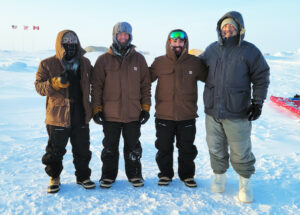
Story by Burrell Parmer
Naval Medical Research Unit San Antonio
JOINT BASE SAN ANTONIO-FORT SAM HOUSTON – (April 25, 2024) – Operating in extreme artic temperatures can be extremely challenging and performing Tactical Combat Casualty Care (TCCC) treatment even more difficult as casualties, donned with large amounts of clothing layers, can make wound assessment and applying medical care, such as tourniquets, much more problematic.
To evaluate seven common TCCC treatment protocols, a team of four research scientists and biomedical engineers assigned to Naval Medical Research Unit (NAMRU) San Antonio’s Combat Casualty Care and Operational Medicine Directorate participated in Arctic Edge 2024 at Joint Base Elmendorf-Richardson, Anchorage, Alaska, March 3-8, and Operation Ice Camp 2024 on the Beaufort Sea, approximately 200 nautical miles north of Deadhorse, Alaska, March 16-21.
According to Dr. William D’Angelo, of Newington, Conn., lead biomedical engineer assigned to NAMRU San Antonio’s Biomedical Systems Engineering and Evaluation Department, treatment protocols have evolved from operations in Iraq and Afghanistan, but it is not known how well they will function if faced with operations in an extreme cold environment.
“During Artic Edge and Operation Ice Camp, we had a TCCC-trained caregiver perform treatment protocols on a trauma manikin with simulated injuries,” said D’Angelo. “Each procedure was broken down to its core steps with the caregiver and trauma manikin outfitted in appropriate extreme cold weather clothing. The aid bag was always kept outside so the medical supplies were cold soaked.”
D’Angelo said a go/no-go task analysis process was utilized to the determine the feasibility of each step from the perspective of the caregiver, the casualty, and the supplies.
“The number of no-go steps, the time it takes to perform the procedure, and the provider’s hand temperatures were measured and compared to baseline data,” said D’Angelo. “The resulting data was collected to inform extreme cold weather treatment guidance and for use in future research and development efforts.”
Arctic Edge 2024 is a U.S. Northern Command-led homeland defense exercise demonstrating the U.S. military’s capabilities in extreme cold weather, joint force readiness, and U.S. military commitment to mutual strategic security interests in the arctic region.
Previously known as Ice Exercise (ICEX), Operation Ice Camp is a three-week operation hosted by U.S. Submarine Forces in collaboration with the Arctic Submarine Laboratory (ASL), and is designed to research, test, and evaluate operational capabilities in the arctic region.
NAMRU San Antonio’s mission is to conduct gap driven combat casualty care, craniofacial, and directed energy research to improve survival, operational readiness, and safety of Department of Defense (DoD) personnel engaged in routine and expeditionary operations.
It is one of the leading research and development laboratories for the U.S. Navy under the DoD and is one of eight subordinate research commands in the global network of laboratories operating under the Naval Medical Research Command in Silver Spring, Md.